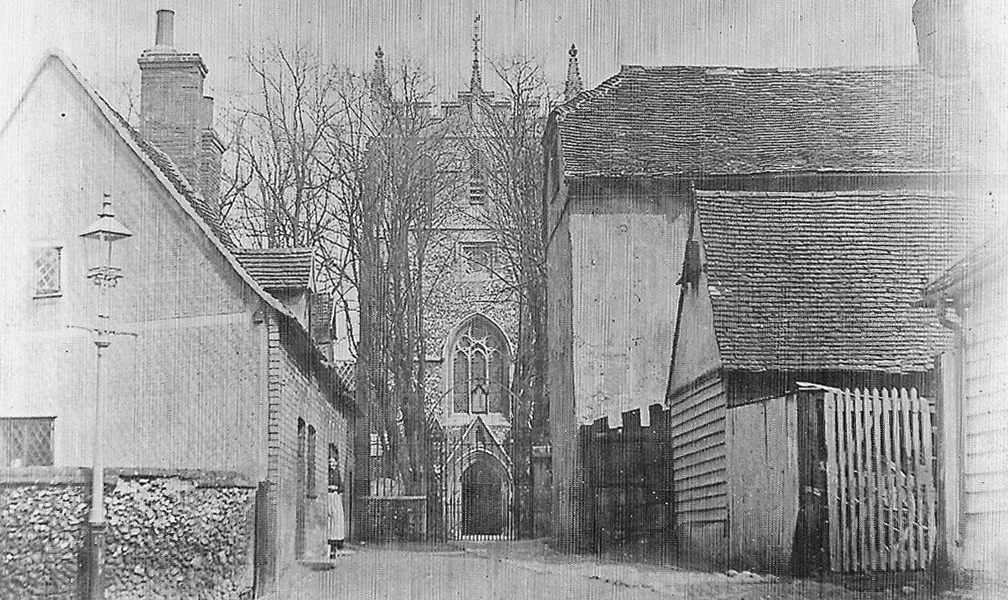Royston and District Local History Society
Frequently Asked Questions
Here are a number of frequently asked questions that are received by the Royston and District LocalHistory Society.
If you cannot find the answer to you question here, please email the society via the link below.

The clock tower and west entrance to St John the Baptist. None of the buildings in the foreground has survived. The wall in the bottom left of the picture is still standing.
Can you help me search for my relatives ?
AnswerAs a local history society, we are mainly interested in the life of the town rather than individuals. We therefore have little information on individual figures in the town. There is the Family History Society based in Cambridge who may be able to help. For details please see our Links page.
I am looking for old photographs of Royston, can you help ?
AnswerThe Society owns a large number of photographs of Royston and these are kept in the Royston Museum. Not all photographs are on public display (we don’t have enough room!) so please contact the curator of the Museum to discuss your particular interests in more details. Contact details are on Royston Museum web site.
There are also a number of books available via the Publications page which contain collections of images of the town.
Do you have old documents relating to businesses / families / buildings in Royston ?
AnswerThe Society does have some documents which can be made available to the public. These are held with the photograph collection and are kept at the Royston Museum so please contact the Museum curator to see if there are any items of interest. Contact details are on Royston Museum web site.
The Society has published a book of bill heads issued by local businesses from the late 18th century until the start of the first World War. See the Publications page for more details.
How can I find out more about Royston Cave ?
AnswerThere are a number of sources of information. The Cave is open Easter to September on Saturdays, Sundays and Bank Holidays from 1.00pm to 3.30pm with last entry at 3.00pm. A guide will show you into the Cave and there is an audio presentation to highlight various features and points of particular interest within the Cave. Several books about the Cave have been published, some written by members of the Society. These are on sale at the Cave Shop (when open), at the Royston Museum, and Bow Books on Angle Pavement. Details of available books are on the Publications page.
There are quite a few sites with information about the Cave -
The Royston Cave web site is the first place to look. It has basic information about the Cave plus news articles and can be found at www.roystoncave.co.uk
“At the Edge - a web site dedicated to exploring new interpretations of past and place in archaeology, folklore and mythology” has 2 pages with background information on the Cave (“Royston Cave” and “Royston Cave and Related Caverns”)
Who can came to the meetings ?
AnswerThe meetings are open to members of the society and the cost of meetings is included in the annual membership. Non-members are also welcome at the meetings and an entrance fee is charged, currently £3.00. For details of meetings and entrance fees, etc. please visit the Programme page.
How do I join the History Society ?
AnswerMost information you might need is on the Membership page and if you would like additional information, please contact the Treasurer for further details or use the email link above..
What geographical area is covered by Royston and District ?
AnswerThe Society is active within Royston and seeks to preserve and enhance those parts of the town within the conservation area. The Society is also keen to record how a town like Royston affects the lives of people in the area, typically within a radius of 10 miles of the town centre - this includes people living in surrounding villages and inhabitants of the town itself.
I don’t live in the area, can I find out if there is a history society local to me ?
AnswerIf you live in Hertfordshire (or maybe in a county bordering Herts.) then you could try looking at Hertfordshire Archives which has a section on local history research..